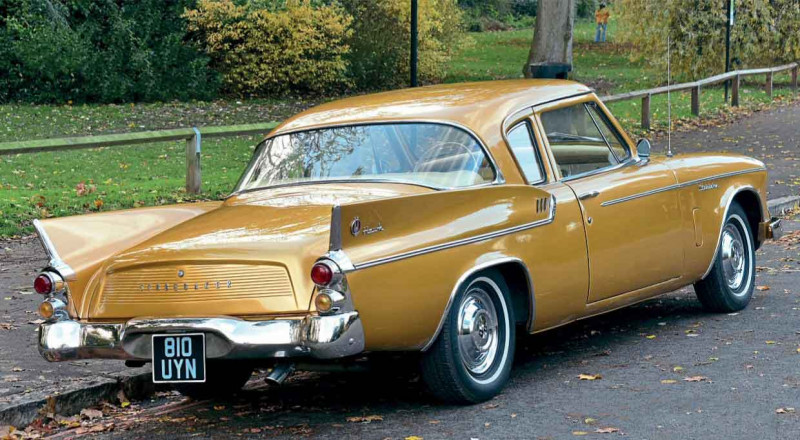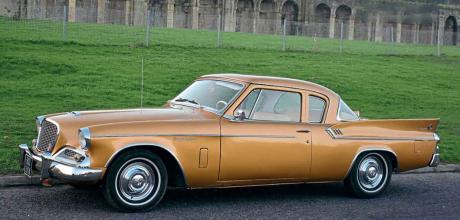1960 Studebaker Hawk
Brian Wrigley’s had plenty of classic Americans in his life, starting as a youngster in the Sixties; could this Studebaker be his finest Yank yet? We reckon so… Words and photography: Zack Stiling.
Museum Quality

Readers of Drives.today don’t need to be told that all classic American cars are quite spectacular in their own way. There are certain individual cars, though, which stand out from the crowd, even on a show field. Brian Wrigley’s 1960 Studebaker Hawk is one such car. The colour, of course, is conspicuous – the autumn gold suggests prosperity, and is a perfect complement for any vista illuminated softly by a low evening sun. However, the same colour on a Cadillac or Buick could be considered vulgar. The Studebaker, which exhibits Raymond Loewy’s European-influenced design ethos, is minimalist and dainty by American standards of the Fifties, and it translates into something resembling genuine good taste. Here is a car that would look equally at home cruising along the Italian Riviera as undertaking a shopping trip in American suburbia.
The Hawk line was introduced in 1956 and was marketed with numerous references to its sports-car properties, Studebaker being eager to sell the car on its European image and the perceived sophistication that went with it. The styling didn’t go unappreciated, and the motoring press was quick to praise it. Writing in 1961, the Australian Wheels magazine summarised it: “Not very finny, it is one of the best-looking of the American-designed cars.” Regardless, the Hawk failed to alleviate any of the struggling marque’s woes. It did not sell well, perhaps because it was targeting a market that didn’t really exist.
It wasn’t a real sports car, of course, so it was never going to steal sales from Corvettes or European two-seaters, but it lacked the size expected of all but the cheapest family cars. With a compact but well-appointed passenger compartment, it fits best into the personal luxury class. Most likely, it was coveted by people who really wanted a Ford Thunderbird but needed an extra row of seats for their pesky children, and one can hardly suppose they accounted for a large share of the market.
The Hawk range appeared when Studebaker- Packard was desperately seeking finance, and they were to be the last of the legendary Studebakers designed by Raymond Loewy’s team. Everything about them was impressive, not just the styling.
With the engines going up to a supercharged 289cu in V8 with the Golden Hawk, performance could be quite enviable, and the low centre of gravity and stiff suspension did allow for something like sports-car handling, creating the potential for a thrilling driving experience. The main criticism expressed by road-testers was that the steering was too low-geared and the turning circle too large.
One of the most noticeable aspects of the Hawk was that it hardly changed throughout its production run from 1956 to 1961, while all the other car-makers were updating their cars annually. Unsurprisingly, the Hawk grew slightly heavier with the weight of bigger wings and added glitz in a bid to appear fresh, but the updates were barely noticeable even on a superficial level. Still, Studebaker made the most of this, and its marketing pitch for 1959 which boasted that the Hawk ‘relies on purity of line rather than ornamentation’ and ‘responds with precision and alacrity’ to ‘a knowledgeable hand on its wheel’ was perhaps unique when everyone else was shouting about fins and gadgets.
Meanwhile, the range was being quietly reduced. What began as a modest range of pillared or pillarless Flight, Power, Sky and Golden Hawks for 1956 was reduced to the Silver and Golden Hawks for ’57 and ’58. The Golden Hawk was dropped for ’59 and for 1960 there was only one Hawk, without any epithet, available only as a pillared coupe.
This was naturally detrimental to sales in a market that valued novelty above all else, and Studebaker found itself caught in a terrible catch-22 situation where it couldn’t generate profits without new specifications to sell, but it couldn’t develop new specifications without the profits to invest in them.
With the market turning more towards economy, it made sense for Studebaker to discontinue the Golden Hawk’s supercharged V8 and introduce a 169.6cu in straight-six for 1959, but sales figures from that year showed that the majority of Hawk buyers believed a sporty-looking car ought to have a sporty engine. As a result, the straight-six was sidelined for the export market only in 1960. After a pitiful 45,000 sales in 1958, it was only the introduction of the compact Lark in 1959 that kept Studebaker on life support for a bit longer and gave the Hawk an extra lease of life. The contribution of the Lark can barely be understated; it sold 127,715 units in 1960 compared with 5977 Hawks.
Brian Wrigley’s example was imported in October 2012 by Norman Perryman of Worthing, who bought it from the closingdown sale of the Wheels of Yesterday Museum in Ocean City, Maryland. The museum was the collection of prominent local businessman Granville Trimper, best known for managing the historic Trimper’s Rides amusement park.
It had apparently been restored in the Nineties in two-tone gold and white, but Perryman wasn’t satisfied with its condition, so he subjected it to a full mechanical overhaul and respray, while replacing the original white vinyl upholstery with magnolia leather. This change is something of a pity as, in its original state, the Hawk’s interior drew praise from Harper’s Bazaar. Neither gold paint nor leather upholstery were applied to the 1960 Hawks, but they were available on the 1957 Golden Hawks. The fact that this car also has 1957 hubcaps points towards previous owners trying to turn it into a Golden Hawk replica. The 289cu in V8 with three-speed column-shift gearbox and two-barrel Stromberg carburettor are part of the Hawk’s original specification, and they make it good for around 20mpg. When new, it would have cost $2650, over $1000 less than the cheapest Thunderbirds.
In the simplest terms, Brian bought the Studebaker because he’s been completely hooked on American cars for more than 50 years. “When I first started driving, my brother and I shared cars as we didn’t have much money. We used to go through Exchange & Mart seeing what American cars were nearby. It was 1966 – there were quite a few in those days. We’d buy an old junker for £30 and sort it out. It usually only needed a water pump, or something like that. We’d go to Lendrum & Hartman, which had all the GM parts, and we’d have a driving car. We changed cars every six months or so. I watched my brother doing a lot of the work as I’m no mechanic; he was the brainy one.”
The first in this long line of Yanks was a ’51 Cadillac, which was followed by a right-hand-drive ’59 Galaxie convertible, and various Chevrolets and Oldsmobiles. “There was a long gap for a while after I got married, then in the Eighties I imported a 1956 Oldsmobile 98. On and off in later years I’ve had a hankering for another one, so I bought a 1961 Oldsmobile Super 88 two-door. That was a nice car. After I sold it, I went through Car & Classic month after month trying to find something I really liked until I settled on this Studebaker.” Brian had fond memories of a die-cast Studebaker he’d had as a child and was keen to try something different.
Since acquiring the Hawk in October 2018, it’s been a fairly easy ride for Brian, with no major obstacles to overcome. Besides the replacement of a leaky radiator hose, the only work undertaken has been a rebuild of the radio with a new rear speaker and a rebuild of the clock so that it runs off the battery, although future plans include a front disc-brake conversion, and the installation of electronic ignition and power steering. “It’s heavy to park at present, especially with radial tyres,” Brian remarks. “The overdrive also needs attention. Parts availability is good and I have imported several items from Studebaker International in Indiana, which is the largest supplier for the make.”
Few people can be better placed than Brian to review the Studebaker in relation to its contemporary rivals, and it’s abundantly clear that he was attracted to the car on account of its brilliant looks, not because it was an easier or more practical proposition. “All the other cars I’ve owned always had power steering and automatic transmissions. My first car was a 1957 Vauxhall Cresta (pre-fins) which I sold for scrap when the half-shaft packed up, so I had to get used to column-change all over again.” Brian’s Hawk doesn’t have a single power feature, so its first owner must have been more interested in its sporty handling than anything else.
Brian is now a signed-up member of the United Kingdom Chapter of the Studebaker Owners’ Club and gives the Stude regular runs out with the Forest Hill & District Classic Car Club. It was on one of these occasions that he found himself the recipient of the Most Unusual award at the Faversham Transport Weekend. Unusual it certainly is, and very beautiful, so we suspect Brian is going to have to get used to swarms of admirers wherever the Stude goes.
Dash is uncluttered and functional. Interior was reupholstered in magnolia. Studebaker in its museum days. Rear panel. Exquisite detail on seatbelt buckles. Stude was restored in the 90s and had a white roof, which was later changed. Parking brake. 210bhp 289cu in V8 engine. Period ad. Owner: Brian Wrigley. 1960 was the penultimate year for tailfins on the Hawk. Golden paint suggests a nod to earlier Golden Hawks.


